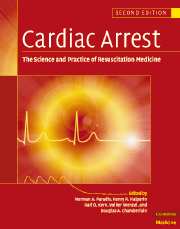Book contents
- Frontmatter
- Contents
- List of contributors
- Foreword
- Preface
- Part I Introduction
- Part II Basic science
- 3 Global cellular ischemia/reperfusion during cardiac arrest: critical stress responses and the postresuscitation syndrome
- 4 Genetics, genomics and proteomics in sudden cardiac death
- 5 Intracellular signaling during myocardial ischemia
- 6 Electrophysiology of ventricular fibrillation and defibrillation
- 7 The neuroendocrine response to global ischemia and reperfusion
- 8 Inflammatory and Immunologic responses to ischemia and reperfusion
- 9 Methodology of laboratory resuscitation research
- 10 The methodology of clinical resuscitation research
- 11 The special problem of consent for resuscitation research
- Part III The pathophysiology of global ischemia and reperfusion
- Part IV Therapy of sudden death
- Part V Postresuscitation disease and its care
- Part VI Special resuscitation circumstances
- Part VII Special issues in resuscitation
- Index
5 - Intracellular signaling during myocardial ischemia
from Part II - Basic science
Published online by Cambridge University Press: 06 January 2010
- Frontmatter
- Contents
- List of contributors
- Foreword
- Preface
- Part I Introduction
- Part II Basic science
- 3 Global cellular ischemia/reperfusion during cardiac arrest: critical stress responses and the postresuscitation syndrome
- 4 Genetics, genomics and proteomics in sudden cardiac death
- 5 Intracellular signaling during myocardial ischemia
- 6 Electrophysiology of ventricular fibrillation and defibrillation
- 7 The neuroendocrine response to global ischemia and reperfusion
- 8 Inflammatory and Immunologic responses to ischemia and reperfusion
- 9 Methodology of laboratory resuscitation research
- 10 The methodology of clinical resuscitation research
- 11 The special problem of consent for resuscitation research
- Part III The pathophysiology of global ischemia and reperfusion
- Part IV Therapy of sudden death
- Part V Postresuscitation disease and its care
- Part VI Special resuscitation circumstances
- Part VII Special issues in resuscitation
- Index
Summary
Introduction
There are several general points to be considered with respect to the perturbations in intracellular signaling that are induced by ischemia and any subsequent reperfusion, and these apply equally to the myocardium and to other tissues. First, what are the changes in the activities of signaling pathways wrought by prolonged periods of ischemia and are these related to any subsequent pathologies? Second, what are the mediators that lead to activation of these signaling pathways and what are the cellular sensors of these mediators? Third, what are the changes that allow short periods of ischemia to be protective against a subsequent period of ischemia that would normally inevitably lead to irreversible myocardial damage (the phenomenon known as ischemic conditioning)? Finally, what are the pharmacological options for intervention so that the damaging effects of ischemia and ischemia–reperfusion can be moderated or the protective effects of conditioning be stimulated? These questions are especially pertinent to the myocardium because the contractile cells (the cardiac myocytes) are terminally differentiated in the adult (i.e., they are incapable of undergoing a complete cycle of cell division), having withdrawn from the cell cycle during the perinatal period. This renders the heart particularly vulnerable to myocyte death such as that occurring during ischemic heart disease because the myocytes that are lost cannot be replaced, and the only palliative alternative is the regional expansion of the preexisting myocyte pool, i.e., cardiac remodeling.
Ischemia and ischemia–reperfusion are associated with gross disturbances in ionic balance and metabolic activity, and increases in the production of reactive oxygen species (ROS).
- Type
- Chapter
- Information
- Cardiac ArrestThe Science and Practice of Resuscitation Medicine, pp. 90 - 100Publisher: Cambridge University PressPrint publication year: 2007

